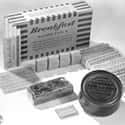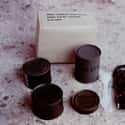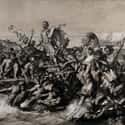-
(#12) WWII Soldiers Were Given Smokes And Chewing Gum
By WWII, the American army developed new rations. Designed to be light and easy to carry, the rations came in three forms: C-ration, D-ration, and K-ration.
C-ration and K-ration contained tinned beef and potatoes, biscuits, toffee, and instant coffee. It usually contained smokes and chewing gum, as well, along with toilet paper. One ration was supposed to last three meals and provided 3,600 calories.
The D-ration was simply a chocolate bar.
-
(#13) Vietnam Soldiers Had Malaria And Diarrhea Pills In Their Rations
During Vietnam, the military introduced MCIs, or Meal, Combat, Individual rations. The unpopular rations included canned meat, which soldiers heated up with C4. The troops also received cans of crackers, cookies, applesauce, and cake. On patrol, soldiers sometimes placed the cans in socks and tied them to their backpacks.
The rations also included a malaria tablet, salt pills, and Lomotil tablets, which soldiers took four times a day to control diarrhea.
-
(#3) The Crusaders Would Stop Mid-Fight To Start Eating Their Homemade Food
In 1095 CE, Pope Urban II called for the First Crusade. Over 100,000 Europeans responded, marching all the way to Jerusalem to retake the city.
In an era without standing armies, soldiers brought food with them. Crusaders probably ate dried meat and porridge, with fruit and cheese if they could afford it. Some soldiers even had to sell their possessions or mortgage their land to supply themselves.
Crusaders thought nothing of stopping mid-fight to eat. During the 1189-1191 CE siege of Acre, twice crusaders halted combat to eat, which helps to explain why it took two years to capture the city.
-
(#1) Spartan Soldiers Drank Black Broth Made From Blood And Pigs' Legs
In ancient Greece, the Spartans built a culture dedicated to combat. Young boys moved into military barracks at age 7 to train. As Roman historian Plutarch explained, "Their training was calculated to make them obey commands well, endure hardships, and conquer..."
In a society dedicated to fighting, the Spartans didn't expect luxurious cuisine. In fact, Spartan soldiers ate black broth made from blood, boiled pigs' legs, and vinegar. Legend claims the soup was so disgusting that Spartans were willing to fall in combat to avoid eating it.
-
(#4) Genghis Khan’s Mongol Warriors Ate 'Saddle Stew'
Genghis Khan and his army conquered the largest land empire in history. With rations of dried milk curd, Mongol warriors managed to conquer territory equivalent to the size of the entire African continent.
The nomadic Mongols weren't farmers, they largely subsisted on their livestock. Mongols divided their diet into white foods and red foods. The white foods, or dairy, included fermented horse milk, while the red foods included meat.
Mongol warriors sometimes stuck a bag of meat, onions, and rice under their saddle while riding. The friction of a day's ride would cook the meat, turning it into a saddle stew. According to Marco Polo, warriors made small punctures in their horses' neck and drank their blood on long rides.
-
(#2) The Romans Relied On Carbohydrates And One Pound Of Meat Per Day
Rome built an army that dominated the ancient world. The army that conquered Europe, Africa, and the Near East benefitted from high-quality provisions. Rome's legions consumed fresh meat and luxurious foods like bacon, cheese, and wine.
Roman legions ate barley and wheat as staples of their diet. The army also consumed a pound of meat per soldier per day. To keep up with the high demand, Roman armies traveled with their own livestock, consuming 120 sheep a day.
The high-calorie diet helped the army cross continents to expand their empire.
New Random Displays Display All By Ranking
About This Tool
Military food culture is produced by the interaction between social food culture and military culture in the long-term military food security practice activities. Soldiers not only need food to survive, but they also need to maintain or strengthen their confidence through enough military rations. Food can also be an incentive for war or a subsidiary product of war, such as canned food. Over the centuries, the military rations in various periods have changed a lot.
You could find more information about the evolution of military rations throughout history on this page, the importance of military rations is self-evident. Few people know that spices also play an important role in military rations.
Our data comes from Ranker, If you want to participate in the ranking of items displayed on this page, please click here.
















